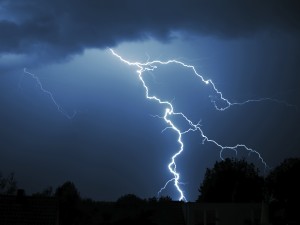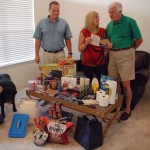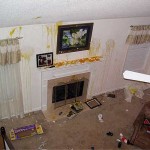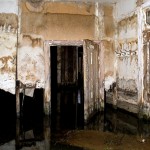Georgia Lightning Awareness Week: June 19-25, 2011
 Tuesday, May 17, 2011 at 04:17PM
Tuesday, May 17, 2011 at 04:17PM  Lightning is one of the leading causes of weather deaths in the United States. From 1995 to 2010, lightning caused 26 deaths in Georgia. Most lightning deaths occur in the summer months - usually in the afternoon and evening hours. Also, most deaths occur when people are caught outside during a storm.
Lightning is one of the leading causes of weather deaths in the United States. From 1995 to 2010, lightning caused 26 deaths in Georgia. Most lightning deaths occur in the summer months - usually in the afternoon and evening hours. Also, most deaths occur when people are caught outside during a storm.
Lightning results from the buildup and release of electrical energy between positive and negative charges between the earth and a thunderstorm. A single lightning bolt can be as hot as 50,000 degrees Fahrenheit - hotter even than the surface of the sun. This rapid heating and cooling of the air creates a shock wave which we hear as thunder. Lightning will usually strike the highest object in area. This includes trees, antennas, a boat on a lake, or a person standing in a field.
So, what should you do to protect yourself?
 Champion Construction Systems,
Champion Construction Systems,  Community News,
Community News,  Current Events,
Current Events,  Education,
Education,  Emergency Planning,
Emergency Planning,  Fire Damage,
Fire Damage,  Georgia,
Georgia,  Insurance,
Insurance,  Storm Damage,
Storm Damage,  Water Damage,
Water Damage,  atlanta,
atlanta,  atlanta ga,
atlanta ga,  champion construction,
champion construction,  disaster planning,
disaster planning,  disaster preparedness,
disaster preparedness,  georgia lightning awareness,
georgia lightning awareness,  georgia lightning awareness week,
georgia lightning awareness week,  lightning safety,
lightning safety,  lightning safety tips,
lightning safety tips,  newnan ga,
newnan ga,  north atlanta,
north atlanta,  sharpsburg
sharpsburg  Email Article
Email Article Be Hurricane Ready This Spring
 Thursday, April 21, 2011 at 11:15AM
Thursday, April 21, 2011 at 11:15AM  Hurricanes in Georgia? Yes! According to the National Oceanic and Atmospheric Administration (NOAA) Georgia is at particular risk of being affected by hurricanes because it is a coastal state. The hurricanes that affect Georgia are severe tropical storms that form in the southern Atlantic Ocean, Caribbean Sea and Gulf of Mexico. Hurricane season lasts from June 1st until November 30th, but the majority of activity is from August until October. Therefore, every state resident and business owner should plan what to do in the event of a hurricane or tropical storm. The following tips can help you keep you and your family safe this hurricane season.
Hurricanes in Georgia? Yes! According to the National Oceanic and Atmospheric Administration (NOAA) Georgia is at particular risk of being affected by hurricanes because it is a coastal state. The hurricanes that affect Georgia are severe tropical storms that form in the southern Atlantic Ocean, Caribbean Sea and Gulf of Mexico. Hurricane season lasts from June 1st until November 30th, but the majority of activity is from August until October. Therefore, every state resident and business owner should plan what to do in the event of a hurricane or tropical storm. The following tips can help you keep you and your family safe this hurricane season.
Preparing for a Hurricane
 Champion Construction Systems,
Champion Construction Systems,  Georgia,
Georgia,  Uncategorized,
Uncategorized,  Water Damage,
Water Damage,  atlanta,
atlanta,  atlanta ga,
atlanta ga,  champion construction,
champion construction,  disaster,
disaster,  disaster planning,
disaster planning,  disaster preparedness,
disaster preparedness,  georgia hurricanes,
georgia hurricanes,  hurricane preparedness,
hurricane preparedness,  hurricane safety,
hurricane safety,  hurricane tips,
hurricane tips,  hurricanes in georgia,
hurricanes in georgia,  newnan ga,
newnan ga,  north atlanta,
north atlanta,  sharpsburg
sharpsburg  Email Article
Email Article HOW TO PREVENT A CLOTHES DRYER FIRE
 Thursday, April 21, 2011 at 11:09AM
Thursday, April 21, 2011 at 11:09AM  Doing laundry is most likely part of your every day routine. But did you know how important taking care of your clothes dryer is to the safety of your home? With a few simple safety tips you can help prevent a clothes dryer fire.
Doing laundry is most likely part of your every day routine. But did you know how important taking care of your clothes dryer is to the safety of your home? With a few simple safety tips you can help prevent a clothes dryer fire.
- Have your dryer installed and serviced by a professional.
- Do not use the dryer without a lint filter.
Should I buy Earthquake Insurance?
 Tuesday, April 12, 2011 at 10:33AM
Tuesday, April 12, 2011 at 10:33AM  This following information is from United Policyholders:
This following information is from United Policyholders:How Do I Know If I Have Hidden Mold?
 Monday, March 21, 2011 at 11:42AM
Monday, March 21, 2011 at 11:42AM Suspicion of hidden mold:
You may suspect hidden mold if a building smells moldy, but you cannot see the source, or if you know there has been water damage and residents are reporting health problems. Mold may be hidden in places such as the back side of dry wall, wallpaper, or paneling, the top side of ceiling tiles, the underside of carpets and pads, etc. Other possible locations of hidden mold include areas inside walls around pipes (with leaking or condensing pipes), the surface of walls behind furniture (where condensation forms), inside ductwork, and in roof materials above ceiling tiles (due to roof leaks or insufficient insulation).
Investigating hidden mold problems
Investigating hidden mold problems may be difficult and will require caution when the investigation involves disturbing potential sites of mold growth. For example, removal of wallpaper can lead to a massive release of spores if there is mold growing on the underside of the paper. If you believe that you may have a hidden mold problem, consider hiring an experienced professional.
Cleanup and Biocides
 Champion Construction Systems,
Champion Construction Systems,  Commercial Property,
Commercial Property,  Community News,
Community News,  Current Events,
Current Events,  Flood Damage,
Flood Damage,  Restoration,
Restoration,  Water Damage,
Water Damage,  atlanta,
atlanta,  atlanta ga,
atlanta ga,  champion construction,
champion construction,  disaster preparedness,
disaster preparedness,  hidden mold,
hidden mold,  how do i know if i have mold,
how do i know if i have mold,  how to clean mold,
how to clean mold,  is mold dangerous,
is mold dangerous,  mold,
mold,  mold cleanup,
mold cleanup,  mold from water damage,
mold from water damage,  mold in home,
mold in home,  mold inspection,
mold inspection,  sharpsburg,
sharpsburg,  toxic mold,
toxic mold,  water
water  Email Article
Email Article Be Prepared for Hailstorms
 Monday, January 24, 2011 at 03:44PM
Monday, January 24, 2011 at 03:44PM
- Listen to weather updates about hail activity.
- Seek shelter immediately if you are caught outdoors - preferably not under a tree.
- Close drapes, blinds or window shades for protection
 Champion,
Champion,  Champion Construction Systems,
Champion Construction Systems,  Community News,
Community News,  Current Events,
Current Events,  Emergency Planning,
Emergency Planning,  Insurance,
Insurance,  Restoration,
Restoration,  Storm Damage,
Storm Damage,  Water Damage,
Water Damage,  atlanta,
atlanta,  atlanta ga,
atlanta ga,  champion construction,
champion construction,  customer service,
customer service,  disaster planning,
disaster planning,  disaster preparedness,
disaster preparedness,  hail damage,
hail damage,  hailstorms,
hailstorms,  newnan ga,
newnan ga,  sharpsburg,
sharpsburg,  tornado,
tornado,  tornadoes
tornadoes  Email Article
Email Article What to Do Before a Thunderstorm
 Monday, January 24, 2011 at 02:32PM
Monday, January 24, 2011 at 02:32PM Remove dead or rotting trees and branches that could fall and cause injury or damage during a severe thunderstorm.
If thunder roars, go indoors" because no place outside is safe when lightning is in the area. We want everyone to stay indoors until 30 minutes have passed after they hear the last clap of thunder.
Summary of Lightning Safety Tips for Inside the Home
- Avoid contact with corded phone.
- Avoid contact with electrical equipment or cords. If you plan to unplug any electronic equipment, do so well before the storm arrives.
- Avoid contact with plumbing. Do not wash your hands, do not take a shower, do not wash dishes, and do not do laundry.
Wintertime Trivia
 Tuesday, November 9, 2010 at 11:03AM
Tuesday, November 9, 2010 at 11:03AM 1. What is the snowiest city in the United States? A. Blue Canyon, California B. Lander, Wyoming C. Syracuse, New York D. Marquette, Michigan The answer is A: Blue Canyon, California with 240.8 inches a year. 2. What state holds the record for the lowest recorded temperature in the United States? A. Maine B. Michigan C. Montana D. Alaska
What To Do If Your Home Is Vandalized
 Thursday, November 4, 2010 at 04:56PM
Thursday, November 4, 2010 at 04:56PM  Carpet & Area Rug Cleaning,
Carpet & Area Rug Cleaning,  Champion,
Champion,  Champion Construction Systems,
Champion Construction Systems,  Community Service,
Community Service,  Company Information,
Company Information,  Emergency Planning,
Emergency Planning,  Insurance,
Insurance,  Restoration,
Restoration,  Water Damage,
Water Damage,  atlanta,
atlanta,  atlanta ga,
atlanta ga,  champion construction,
champion construction,  disaster,
disaster,  disaster planning,
disaster planning,  disaster preparedness,
disaster preparedness,  newnan ga,
newnan ga,  north atlanta,
north atlanta,  vandalism,
vandalism,  vandalism dos and donts,
vandalism dos and donts,  what to do if you have a vandlism,
what to do if you have a vandlism,  what to do if your home is vandalized
what to do if your home is vandalized  Email Article
Email Article What To Do If You Have A Water Damage
 Thursday, October 28, 2010 at 04:46PM
Thursday, October 28, 2010 at 04:46PM  Champion,
Champion,  Champion Construction Systems,
Champion Construction Systems,  Commercial Property,
Commercial Property,  Community News,
Community News,  Community Service,
Community Service,  Company Information,
Company Information,  Education,
Education,  Emergency Planning,
Emergency Planning,  Flood Damage,
Flood Damage,  Insurance,
Insurance,  Restoration,
Restoration,  Storm Damage,
Storm Damage,  Water Damage,
Water Damage,  atlanta ga,
atlanta ga,  commercial water damage,
commercial water damage,  disaster,
disaster,  disaster planning,
disaster planning,  disaster preparedness,
disaster preparedness,  dos and donts of water damage,
dos and donts of water damage,  faster service,
faster service,  mitigation,
mitigation,  north atlanta,
north atlanta,  residential water damage,
residential water damage,  safety,
safety,  sharpsburg,
sharpsburg,  water damage restoration,
water damage restoration,  water damage safety,
water damage safety,  water damage tips,
water damage tips,  what to do if you have a water damage,
what to do if you have a water damage,  worlds fastest drying
worlds fastest drying  Email Article
Email Article 


